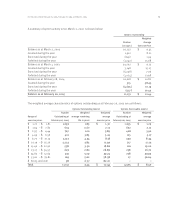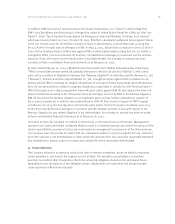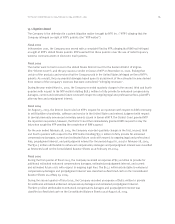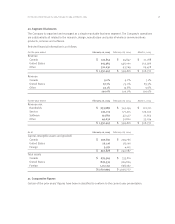Blackberry 2005 Annual Report Download - page 65
Download and view the complete annual report
Please find page 65 of the 2005 Blackberry annual report below. You can navigate through the pages in the report by either clicking on the pages listed below, or by using the keyword search tool below to find specific information within the annual report.
63
In addition, RIM has received communications from Eatoni Ergonomics, Inc. (
“
Eatoni”), which allege that
RIM’s 7100 BlackBerry handheld product infringes the claims of United States Patent No. 6,885,317 (the
“
317
Patent”), titled “Touch-Typable Devices Based On Ambiguous Codes And Methods To Design Such Devices”,
which was issued on April 26, 2005. On April 28, 2005, RIM filed a declaratory judgment action against Eatoni
in the U.S. District Court for the Northern District of Texas, Dallas Division, in which RIM seeks a ruling that
the 317 Patent is invalid and not infringed by RIM. On May 4, 2005, Eatoni filed a complaint in the U.S. District
Court for the Southern District of New York against RIM, in which Eatoni seeks a ruling that the 317 Patent is
infringed by RIM’s 7100 series devices. At this time, the likelihood of damages or recoveries and the ultimate
amounts, if any, with respect to the Eatoni action is not determinable. Accordingly, no amount has been
recorded in these consolidated financial statements as at February 26, 2005.
By letter dated February 16, 2004, T-Mobile Deutschland GmbH and T-Mobile International AG (collectively,
“TMO”) served RIM’s wholly-owned UK subsidiary Research In Motion UK Limited (“RIM-UK”), with a third
party notice in relation to litigation in Germany (the “Neomax Litigation”) in which the plaintiff, Neomax Co., Ltd.
(“Neomax”), formerly Sumitomo Special Metals Co., Ltd., brought an action against TMO in relation to cell
phones sold by TMO in Germany for alleged infringement of a European Patent purportedly owned by Neomax,
which in very general terms, relates to magnets installed as components in cell phones (the “Neomax Patent”).
TMO’s third party notice seeks unquantified indemnification claims against RIM UK (and against the other cell
phone manufacturers named in the third party notice) for damages incurred by TMO in the Neomax Litigation.
RIM UK has joined the Neomax Litigation as an impleaded party and has further impleaded its supplier of
the accused components in order to seek indemnification. RIM UK filed a brief in support of TMO’s appeal
on February 28, 2005, the hearing which will not take place before the fourth quarter of calendar year 2005.
At this time, the likelihood of damages or recoveries and the ultimate amounts, if any, with respect to the
Neomax Litigation (or any related litigation) is not determinable. Accordingly, no amount has been recorded
in these consolidated financial statements as at February 26, 2005.
From time to time, the Company is involved in other claims in the normal course of business. Management
assesses such claims and where considered likely to result in a material exposure and, where the amount of the
claim is quantifiable, provisions for loss are made based on management’s assessment of the likely outcome.
The Company does not provide for claims that are considered unlikely to result in a significant loss, claims for
which the outcome is not determinable or claims where the amount of the loss cannot be reasonably estimated.
Any settlements or awards under such claims are provided for when reasonably determinable.
13. Product Warranty
The Company estimates its warranty costs at the time of revenue recognition, based on historical warranty
claims experience, and records the expense in Cost of sales. The warranty accrual balance is reviewed
quarterly to establish that it materially reflects the remaining obligation, based on the anticipated future
expenditures over the balance of the obligation period. Adjustments are made when the actual warranty
claim experience differs from estimates.
For the years ended February 26, 2005, February 28, 2004 and March 1, 2003
























